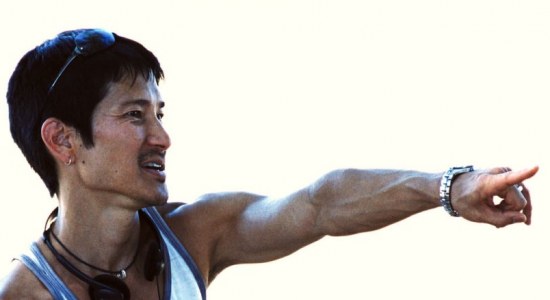Gregg Araki is most recently the writer and director of Kaboom, which opens today in theaters.
Listen: Play in new window | Download (Running Time: 24:30 — 22.4MB)
Condition of Mr. Segundo: Staring at the canvas from a low angle.
Guest: Gregg Araki
Subjects Discussed: Whether or not Gregg Araki looks fantastic, the camera’s height growing up over twenty years of Araki’s films, the universe as a dangerous place, Chevron gas stations, the Vermeer in Mysterious Skin, backdrops, location in its natural light, how much a moment is dictated by landscape, Araki’s later films beginning in media res, Kaboom as a reaction to movies that Araki can outthink, hating being “ahead of the movie,” Inception, the way in which Araki sends emails, creating more complex narratives in a short attention span age, movie running times, deleted scenes, a secret subplot about Thor, not yet dealing with characters over the age of thirty or post-college life, getting pigeonholed as “the teenage movie guy,” being a confused and angst-ridden undergraduate, fondness and optimism, the frequency of mothers in Araki’s films, gender balance, screwball comedies, Bringing Up Baby, Cary Grant as a dumb blonde, James Duval’s return in Kaboom, trying to find innovation when “every film has been done,” an alternative juxtaposition of the Wicked Witch of the West, and returning to a naive place.
EXCERPT FROM SHOW:
Correspondent: Gregg, how are you doing?
Araki: (with some irony) I am doing fantastic.
Correspondent: End of the day. Uh, no visuals. But anyway…
Araki: In other words, “you don’t look fantastic.”
Correspondent: You do look fantastic! You look like…
Araki: Can we say “shit” on this?
Correspondent: You can. You can say “shit.” We can talk Totally Fucked Up. Whatever you want.
Araki: Okay. Good. Yeah, I look like shit.
Correspondent: You have exacting standards. I wanted to talk about your aesthetic. I noticed that over the course of twenty years, the camera’s position has actually grown. It started off as being very much on the floor.
Araki: (laughs)
Correspondent: Very on the ground. You would see giant billboards. Chevron gas stations. And as we’ve seen you evolve as a filmmaker, we’ve seen the camera actually rise up from the ground.
Araki: Interesting.
Correspondent: And I’m curious about how this aesthetic built.
Araki: In this film [Kaboom], there’s that crazy crane shot.
Correspondent: Yeah.
Araki: Interesting. That’s an interesting metaphor for my filmmaking style. It’s gone from underground to above ground.
Correspondent: Yes, exactly. Well, actually, roughly, the camera’s waist-high.
Araki: Yeah, I used to use a lot of what’s called a hi-hat. It’s just a plank of wood with a tripod head. And I was concentrating on the hi-hat a lot.
Correspondent: Was this more your way to look distinct? Because you had pretty much nothing but a hi-hat?
Araki: I think it was also just aesthetically appealing to me. And I think it’s partly — you know, my movies are about these characters who are in this vast, hostile universe. And I think that you get that — particularly with a wide angle, a wide low shot, you get a sense of this universe being this vast and dangerous place. I think that sense of space comes a lot from that angle. You get a sense of that openness.
Correspondent: Well, I’m curious about space. I was mentioning the Chevron gas station. And we see, for example, the Vermeer in Mysterious Skin. In this movie, at the cafe, there’s the big space in the back where we see WELCOME TO THE ONTOLOGICAL VOID. I’m curious as to how this also developed. This large widescreen environment for characters to often walk into and go ahead and bitch and moan.
Araki: You brought up many interesting things that will be in dissertations done on my movies after I’m dead, I’m guess.
Correspondent: Ah.
Araki: Because a lot of my movies — particularly the early, early ones, the black-and-white, the two ones that were before The Doom Generation — is frequently characters walking at night against these phantasmagorical backdrops of Los Angeles landscape. Usually talking about the meaningless of existence. And it’s something that’s been in a lot of my movies. There is still that sense, even in Kaboom. There’s a shot in particular that’s very, very similar to one of those shots. Because I remember we were on the hi-hat. The shot where Smith is being chased by the animal men, and he runs into that crazy weird stairwell that’s almost something out of a nightmare. That shot is very reminiscent of those shots. Because it’s also so much about the location and its natural light. It’s this weird lit-up stairwell, but the DP did light it. Most of the stuff is actually from the structure itself.
Listen: Play in new window | Download (Running Time: 24:30 — 22.4MB)

1 Comment